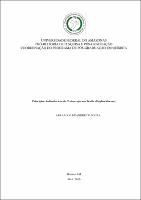| ???jsp.display-item.social.title??? |


|
Please use this identifier to cite or link to this item:
https://tede.ufam.edu.br/handle/tede/6143| ???metadata.dc.type???: | Dissertação |
| Title: | Princípios Antimaláricos de Croton cajucara Benth. (Euphorbiaceae) |
| ???metadata.dc.creator???: | Souza, Abraão Alexandre de  |
| ???metadata.dc.contributor.advisor1???: | Pohlit, Adrian Martin |
| First advisor-co: | Torres, Zelina Estevam dos Santos |
| ???metadata.dc.contributor.referee1???: | Azevedo, Mariângela de Burgos |
| ???metadata.dc.contributor.referee2???: | Lima, Maria da Paz |
| ???metadata.dc.description.resumo???: | A malária é uma das doenças endêmicas mais relevantes nas regiões tropicais cujo o tratamento está baseado em substâncias descobertas a partir de plantas utilizadas tradicionalmente na medicina popular. Assim, diante da resistência do parasita (Plasmodium spp.), a busca por novas drogas se tornou fundamental. Entre as substâncias bioativas de espécies vegetais, os terpenóides apresentam-se com uma gama de atividades biológicas, dentre as quais se destacam a antimalárica. Diante disso, esta pesquisa teve por objetivo o isolamento de substâncias com potencial antimalárico. A espécie que têm indicação como antimalárica e que foi utilizada no presente estudo é facilmente encontrada e além disso é cultivada no Estado do Amazonas na EMBRAPA e INPA: ‘sacaca’ (Croton cajucara Benth). As cascas e folhas de ‘sacaca’ Croton cajucara Benth (Euphorbiaceae) foram submetidos para preparo de extratos bioativos, com relevancia na atividade antimalárica. Onde se observou boa atividade do extrato clorofórmico das folhas no bioensaio in vitro frente a cepa K1 de P. Falciparum, com CI50 = 6,4 ± 1,2 µg/mL, seguida do extrato etanólico das cascas, com CI50 = 17,2 ± 6,6. Os extratos foram investigados por meio de uma abordagem fitoquimica tradicional, baseada no fracionamento cromatografico em coluna aberta, resultando no isolamento de sete substâncias. A substancia natural 1 foi acetilado numa reação de anidrido acetico (Ac2O) e piridina (C5H5N), resultando no composto 2. Estes oito compostos foram identificados principalmente por meio de análises de RMN 1H e 13C 1D e 2D e CL-EMAR. Em seguida as oito substâncias passaram por screening para avaliar suas atividade antiplasmódica em duas concentrações (50 e 5 µg/mL): Os resultados revelam que apenas três compostos apresentaram inibição acima de 50% (1, 2 e 6), mas o composto (6) apresentou melhor atividade ao inibir mais de 80% do crescimento in vitro da cepa K1 de P. Falciparum: 70,5-68,0 (1); 63,9-55,6 (2); 57,6-0 (3); 41,8-37,2 (4); 18,6-23,2 (5); 92,7-75,6 (6); 34,9-23,2 (7) e 37,2-11,6 (8). O 1 e 6 tiveram suas CI50 calculadas, onde apresentaram atividades moderadas in vitro contra cepa de P. Falciparum, com CI50= 23,7 e 23,0 µg/mL, respectivamente. O composto 1 foi o unico a ser testado in vivo, no entanto não apresentou atividade frente ao P. berghei, por via oral e subcutânea durante o período de sete dias de tratamento |
| Abstract: | Malaria is one of the most important endemic diseases in tropical regions whose treatment is based on substances discovered from plants traditionally used in folk medicine. Thus, faced with the resistance of the parasite (Plasmodium spp.), The search for new drugs has become fundamental. Among the bioactive substances of plant species, terpenoids have a range of biological activities, among which antimalarial. Therefore, the objective of this research was the isolation of substances with antimalarial potential. The species that are indicated as antimalarial and that was used in the present study is easily found and is also cultivated in the State of Amazonas in EMBRAPA and INPA: 'sacaca' (Croton cajucara Benth). Croton cashews and leaves of Benth (Euphorbiaceae) were submitted for the preparation of bioactive extracts, with relevance in the antimalarial activity. In the in vitro bioassay of the P. falciparum K1 strain, IC50 = 6.4 ± 1.2 μg / mL, followed by the ethanolic extract of the bark, with IC 50 = 17.2 ± 6.6. The extracts were investigated by means of a traditional phytochemical approach, based on the open column chromatographic fractionation, resulting in the isolation of seven substances. Natural substance 1 was acetylated in a reaction of acetic anhydride (Ac 2 O) and pyridine (C 5 H 5 N), resulting in compound 2. These eight compounds were identified primarily by 1 H and 13 C 1 D and 2 D and CL-EMAR NMR analyzes. The results showed that only three compounds had inhibition above 50% (1, 2 and 6), but the compound (1) and (2) 6) showed better activity by inhibiting more than 80% of in vitro growth of P. falciparum strain K1: 70.5-68.0 (1); 63.9-55.6 (2); 57.6-0 (3); 41.8-37.2 (4); 18.6-23.2 (5); 92.7-75.6 (6); 34.9-23.2 (7) and 37.2-11.6 (8). 1 and 6 had their IC50 calculated, where they presented moderate in vitro activity against P. falciparum strain, with IC 50 = 23.7 and 23.0 μg / mL, respectively. Compound 1 was the only one to be tested in vivo, however it did not show activity against P. berghei, orally and subcutaneously during the seven day treatment period. |
| Keywords: | Fitoquimica Malária Substâncias antimaláricas |
| ???metadata.dc.subject.cnpq???: | CIÊNCIAS EXATAS E DA TERRA: QUÍMICA |
| Language: | por |
| ???metadata.dc.publisher.country???: | Brasil |
| Publisher: | Universidade Federal do Amazonas |
| ???metadata.dc.publisher.initials???: | UFAM |
| ???metadata.dc.publisher.department???: | Instituto de Ciências Exatas |
| ???metadata.dc.publisher.program???: | Programa de Pós-graduação em Química |
| Citation: | SOUZA, Abraão Alexandre de. Princípios Antimaláricos de Croton cajucara Benth. (Euphorbiaceae). 2016. 136 f. Dissertação (Mestrado em Química) - Universidade Federal do Amazonas, Manaus, 2016. |
| ???metadata.dc.rights???: | Acesso Aberto |
| ???metadata.dc.rights.uri???: | http://creativecommons.org/licenses/by-nc-nd/4.0/ |
| URI: | http://tede.ufam.edu.br/handle/tede/6143 |
| Issue Date: | 20-Apr-2016 |
| Appears in Collections: | Mestrado em Química |
Files in This Item:
| File | Description | Size | Format | |
|---|---|---|---|---|
| Dissertação_Abraão A. Souza.pdf | 4.13 MB | Adobe PDF |  Download/Open Preview |
This item is licensed under a Creative Commons License





